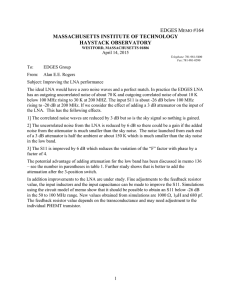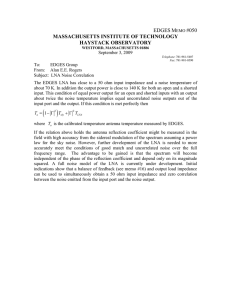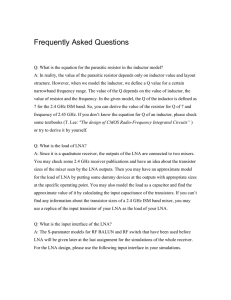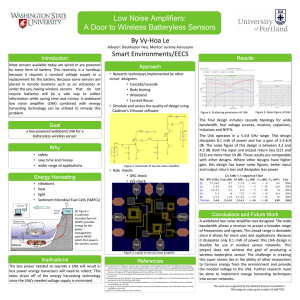Analysis and Design of Single-ended Inductively
advertisement
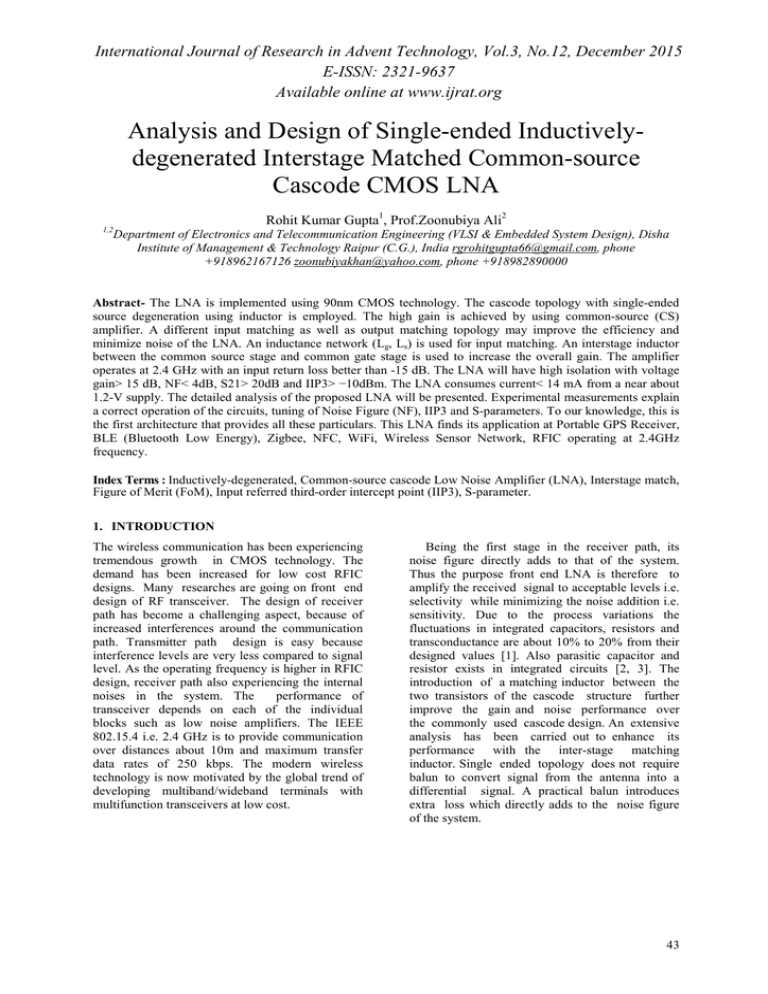
International Journal of Research in Advent Technology, Vol.3, No.12, December 2015 E-ISSN: 2321-9637 Available online at www.ijrat.org Analysis and Design of Single-ended Inductivelydegenerated Interstage Matched Common-source Cascode CMOS LNA Rohit Kumar Gupta1, Prof.Zoonubiya Ali2 1,2 Department of Electronics and Telecommunication Engineering (VLSI & Embedded System Design), Disha Institute of Management & Technology Raipur (C.G.), India rgrohitgupta66@gmail.com, phone +918962167126 zoonubiyakhan@yahoo.com, phone +918982890000 Abstract- The LNA is implemented using 90nm CMOS technology. The cascode topology with single-ended source degeneration using inductor is employed. The high gain is achieved by using common-source (CS) amplifier. A different input matching as well as output matching topology may improve the efficiency and minimize noise of the LNA. An inductance network (Lg, Ls) is used for input matching. An interstage inductor between the common source stage and common gate stage is used to increase the overall gain. The amplifier operates at 2.4 GHz with an input return loss better than -15 dB. The LNA will have high isolation with voltage gain> 15 dB, NF< 4dB, S21> 20dB and IIP3> −10dBm. The LNA consumes current< 14 mA from a near about 1.2-V supply. The detailed analysis of the proposed LNA will be presented. Experimental measurements explain a correct operation of the circuits, tuning of Noise Figure (NF), IIP3 and S-parameters. To our knowledge, this is the first architecture that provides all these particulars. This LNA finds its application at Portable GPS Receiver, BLE (Bluetooth Low Energy), Zigbee, NFC, WiFi, Wireless Sensor Network, RFIC operating at 2.4GHz frequency. Index Terms : Inductively-degenerated, Common-source cascode Low Noise Amplifier (LNA), Interstage match, Figure of Merit (FoM), Input referred third-order intercept point (IIP3), S-parameter. 1. INTRODUCTION The wireless communication has been experiencing tremendous growth in CMOS technology. The demand has been increased for low cost RFIC designs. Many researches are going on front end design of RF transceiver. The design of receiver path has become a challenging aspect, because of increased interferences around the communication path. Transmitter path design is easy because interference levels are very less compared to signal level. As the operating frequency is higher in RFIC design, receiver path also experiencing the internal noises in the system. The performance of transceiver depends on each of the individual blocks such as low noise amplifiers. The IEEE 802.15.4 i.e. 2.4 GHz is to provide communication over distances about 10m and maximum transfer data rates of 250 kbps. The modern wireless technology is now motivated by the global trend of developing multiband/wideband terminals with multifunction transceivers at low cost. Being the first stage in the receiver path, its noise figure directly adds to that of the system. Thus the purpose front end LNA is therefore to amplify the received signal to acceptable levels i.e. selectivity while minimizing the noise addition i.e. sensitivity. Due to the process variations the fluctuations in integrated capacitors, resistors and transconductance are about 10% to 20% from their designed values [1]. Also parasitic capacitor and resistor exists in integrated circuits [2, 3]. The introduction of a matching inductor between the two transistors of the cascode structure further improve the gain and noise performance over the commonly used cascode design. An extensive analysis has been carried out to enhance its performance with the inter-stage matching inductor. Single ended topology does not require balun to convert signal from the antenna into a differential signal. A practical balun introduces extra loss which directly adds to the noise figure of the system. 43 International Journal of Research in Advent Technology, Vol.3, No.12, December 2015 E-ISSN: 2321-9637 Available online at www.ijrat.org 2. MOTIVATION The common approach for designing a narrowband LNA is to use a cascode amplifier with inductive degeneration where as the concept of multiband or wideband concurrent receiver [4] for GPS and Bluetooth application has been used. Fig.1 [5] shows narrowband LNA. This architecture provides simultaneous input matching and low NF. The output tank circuit is tuned to the required band and the input series resonant circuit is adjusted to provide sufficient matching at the desired frequency band. The NF defined in (2) is the lowest NF that can be obtained from this architecture, while the input is perfectly matched and the output is tuned to the operating frequency [5]. The same conclusion holds for the gain defined in (3). These results indicate that the performance of the narrowband LNA depends on the resonant frequency, which is adjusted using the inductor L1 at the input matching network and inductor LD & capacitor at the output tank circuit. LNA CONCEPT, TOPOLOGY AND NOISE FIGURE Conceptually LNA can be foreseen as a cascade of three blocks as the input matching network, amplifier and an output matching network as shown in the Fig.2. Fig.2. Concept of LNA LNA is fabricated using the different MOS topologies that act as an amplifier along with the biasing circuitry. LNA design practice using resistors is generally avoided to have low noise figure [2]. Noise Figure of the first stage greatly decreases the Noise Figure of system, as this is validated by Frii’s equation: Fig.1. Basic circuit of CMOS LNA For this LNA, the input impedance is approximately calculated from [5] Zin = jω (L1+Ls) + (1/jωCgs) + ωTLs (1) Where, ω is the frequency of operation in radians per seconds, ωT is the transistor cut-off frequency in radians per seconds, and Cgs is the gate–source capacitance of the main transistor. The real part of the input impedance Zin is adjusted using the source inductor Ls, while the imaginary part is removed at the resonant frequency using the inductor L1. The NF and the gain at the resonance frequency ω0 are obtained by [5] NF (ω0) = 1+ χ.γ.gdo (M1).Rs (ω0/ωT) 2 (2) A (ω0) = (RL/2RS) (ω0/ωT) (3) ω0 = ((1/ (L1+Ls) Cgs )1/2 (4) Where, gdo (M1) is the zero bias drain transconductance of M1, γ is the noise coefficient, χ is the excess noise factor due to the gate noise, Rs is the source resistance and RL is the load resistance. F = F1+ (F2-1)/A12 + (F3-1)/A12.A22 (5) Thus, it becomes very important to have as low Noise Figure as possible for the first stage. 3. PROPOSED LNA ARCHITECTURE The proposed architecture is of single-ended cascade type having good frequency response offered by common-gate (CG), also high input resistance and transconductance provided by common-source (CS) amplifier [2, 5] as shown in Fig.3. Fig.3. Inductively degenerated Interstage cascade LNA. matched CS 44 International Journal of Research in Advent Technology, Vol.3, No.12, December 2015 E-ISSN: 2321-9637 Available online at www.ijrat.org A. LNA DESIGN & INPUT MATCHING THEORY B. PRINCIPLE OF INTERSTAGE MATCHING & REVERSE ISOLATION Cascode architecture has been used to increase forward gain while decreasing the reverse gain and providing better isolation between input and output ports [5]. Inductive source degeneration is used for input impedance matching and improves stability. This also increases the stability of the LNA through negative feedback at the expense of lower gain. At resonance, the input resistance is [2] Rin = Re [Zin] = GmLs/Cgs (6) Indicating that the combination of the transistor with the degeneration inductor provides input matching. Also at this frequency, ω2 (Lg+Ls) Cgs = 1 (7) The gain of the LNA in Fig. is given by the following, (VOUT/VIN) = (-Gm.s.Ld) / (1-ω2 Cgs(Lg+Ls) + s.Ls.Gm) (8) And when substituting (7) into (8) will give (VOUT/VIN) = (-Ld/Ls) Thus, Gain = 20 log (VOUT/VIN) dB (9) (10) This expression shows that the gain is the ratio of the inductor at the drain to the inductor at the source. A high gain can be achieved if Ld is made much higher than Ls. However, there exist a trade-off between the size of Ld and the output performance of the circuit due to the series resistance of the inductor. The initial stage was to determine the size of the transistor. This was achieved by adopting the power constrained noise optimization method which uses the following equation in determining the width of M1 [1]. Wopt ≈ 1.5(ωoLCoxRsQin opt,PD)-1 (11) Where, Wopt is the optimum width of the transistor having the lowest noise figure (NF), L is the length of the transistor, Cox is the oxide capacitance, Rs is the source (input) resistance and Qin opt,PD is the input circuit quality factor which equals to 4 as obtained from the derivation [2]. Wopt was then calculated. Once width is known, M1’s transconductance and Cgs can be calculated from the general equations for MOSFETs in saturation. Capacitance C1 is linked to terminals of M1 in order to reduce value of input matching inductor Lg. Input match condition for the desired band is obtained by utilizing inductors Ls and Lg along with capacitor C2. IMPEDANCE The introduction of an interstage inductor enhances the gain of the cascode LNA. Thus Lin serves as inter-stage matching between drain of M1 and source of M2 i.e. improve intermediate node power transfer. Also, the reduction of Zin due to inclusion of Lin allows more current to pump toward the M2. Therefore, the inter-stage inductor LNA can provide more gain and less miller effect. It will also help to improve the output matching. An inter-stage inductor is thus added between the common- source and common-gate stage. Because of good power transfer in the common-gate stage, the overall noise figure will be decreased [9]. It must be noted that with change in Lin, the interstage inductor, the input impedance of M1 changes, hence the input matching network must be readjusted to yield 50Ω impedance. The gain improvement with Lin can explain intuitively. With increase in Lin increase the value of 'C'; that effectively reduces the value of 'F' and voltage gain of amplifier improves with Lin. Above analysis shows that, the interstage LNA can be further enhanced by increasing the inductor value (Lin). However, use of high value inductor is constrained by the requirement of larger silicon area, limited quality factor and low resonance frequency. The fully on-chip realization of the circuit limits the maximum achievable value of Lin. We thus choose Lin depending on the gain requirement. The presence of Lin enhances the effective transconductance and effective Quality factor of the circuit. As a result, noise performance improves. This improvement is more pronounced if the inter-stage matching inductor is off chip, thus avoiding large parasitic capacitance. However for on chip realization of the inductor the noise associated with the series resistance tends to cancel the noise improvements and thus keeps the noise performance unchanged. Also enhancing the Cgd feed-through causes degradation of reverse isolation, implies decrease in LNA stability due to mutual coupling. So inter-stage inductor increases the gain but at the cost of lower stability factor. M3and R1form a current mirror circuit with M1. R3 isolates the signal path from the biasing circuit and in this way enforces the input signal to the LNA input. The value of R3 is not critical as long as it is much greater than the input impedance of the stage prior to it. In this work R3 is 2.5 kΩ [2]. Typically, single transistor M1 is sufficient to provide amplification. Adding M2 improves isolation and increases the gain and as a consequence Noise Figure and linearity get deteriorated. Stability of the circuit is determined by the Stern’s stability factor which is given as: 45 International Journal of Research in Advent Technology, Vol.3, No.12, December 2015 E-ISSN: 2321-9637 Available online at www.ijrat.org K = (1+│△│2-│S11│2-│S22│2) / (2│S21││S12│) Where, (12) = S11.S12-S21.S22 C. OUTPUT MATCHING THEORY M4 lowers the local oscillator leakage produced by the following mixer and improves the stability of the circuit by minimizing the feedback from the output to the input [6]. An analog output buffer is incorporated with the LNA to get a better output matching response across all the frequency bands. Ld and Cd provides output matching. Besides this, their combination at resonance enables additional filtering to the output. In addition to these, the voltage drop across the inductor is contributed by its series resistance only and hence, this configuration is very attractive for low power design. The proposed CMOS LNA has been simulated in 90nm using TANNER and LTspice simulator. The Noise Figure of LNA can be reduced by the following factors: (1) improving the quality factor (Q) of the on-chip inductors as parasitic parameters like eddy current loss, parasitic capacitance induced by skin effect of inductor and thermal noise of parasitic impedance of the circuit. (2) Channel noise factor γ of short-channel MOS device is related to the biasing network; (3) the thermal noise of gate resistance of MOSFET also contributes to the output noise of the LNA. Much better performance of the proposed architecture can be expected if the design is implemented in advanced RF substrates. A tradeoff is usually made between maximizing gain and minimizing the noise figure. This is a great challenge in LNA circuit design. This dilemma has been solved in my design. 4. LINEARIZATION OF THE PROPOSED LNA Out of the available techniques for linearization of LNAs’ [10], techniques that target improvising IIP3 only are Feedback, Optimal Biasing, Harmonic Termination, Feedforward, Derivative Superposition, etc. Every technique targets the nonlinear Gm3 characteristics of MOS, and try to fetch linearization at point when MOS swings from subthreshold to saturation region. Gm of MOS in saturation is given as: Gm = (∂Id/∂VGS) │VDS, constant (13) Gm = µn Cox (W/L) (VGS-Vt) Fig.4. Noise figure of the LNA (Minimum Noise Figure is 1.986 dB at 2.4 GHz). (14) The linearity of the amplifier is measured by the input-referred third-order intercept point (IIP3). The IIP3 is inversely proportional to square of the effective Quality factor of input tuning circuit. Hence the introduction of Lin causes the linearity performance of the LNA to deteriorate. IIP3 in terms of Gm1and Gm3is given as: IIP3 = ((4│Gm1│)/ (3│ Gm3│)) 1/2 (15) 5. SIMULATION AND EXPERIMENTAL RESULTS Fig.5. Voltage magnitude (19.1dB) and Phase magnitude (deg) at 2.4 GHz. 46 International Journal of Research in Advent Technology, Vol.3, No.12, December 2015 E-ISSN: 2321-9637 Available online at www.ijrat.org 6. CONCLUSION This paper also shows the effect of inter-stage matching and shows that the addition of the inter-stage matching inductor increases gain. The cascode topology at the first stage with source degeneration inductor and common-source (CS) amplifier help to increase the gain. The proposed LNA is suitable for high gain and high linearity Bluetooth receivers. The design and implementation of 1.2V 90nm CMOS LNAs has been presented. Experimental measurements have been included, showing a competitive behaviour as compared with the state-of-the art on narrowband LNAs. From the charts we can seen that the LNA has sufficient gain along with the noteworthy values of Noise Figure. IIP3 achieves optimize value which is sufficiently enough to suppress unwanted third order inter-modulations at the output of the LNA circuit. Figure of Merit i.e. FoM for LNA circuits is given as: FoM = (│S21│.BW) / ((NF-1).PDC) (16) A comparison table show the comparison of different LNA works formerly accomplished along with the work presented in this paper. From the table we can easily observe that the work carried out in this paper gives least value of noise figure and also has comparatively superlative value of IIP3. In the history of the sciences of developing technology, every forward step requires a correct concept and diligent practice. REFERENCES [1] D.A. Johns and K. Martin, “Analog Integrated Circuit Designs”, John Wiley & Sons. Inc., 1997. [2] T.H. Lee, “The design of CMOS radio-frequency integrated circuits”, Cambridge University Press, 1998. [3] B. Razavi, “RF Microelectronics”, Prentice-Hall International Editions, 1998. [4] H. Hashemi and A. Hajimiri, “Concurrent multiband low-noise amplifiers-theory, design, and applications”, IEEE Trans. Microw. Theory Tech., Vol. 50, no. 1, pp. 288–301, Jan. 2002. [5] D. Shaeffer and T. H. Lee, “Correction to A 1.5-V, 1.5GHz CMOS low noise amplifier”, IEEE J. Solid-State Circuits, Vol. 40, pp. 1397–1398, June2005. [6] S.A.Z. Murad; R.C. Ismail; M.N.M. Isa; M.F. Ahamd and W.B. Han, “High Gain 2.4 GHz CMOS Low Noise Amplifier for Wireless Sensor Network Application”, IEEE International RF and Microwave Conference (RFM2013), December 2013. [7] B. Razavi, 2005, “Design of Analog CMOS Integrated Circuits”, McGraw-Hill Higher Education (1 Oct 2003), ISBN 0-07-23. [8] Ickjin Kwon and Hyungcheol Shin , “Design of a New Low-Power 2.4 GHz CMOS LNA” , Journal of the Korean Physical Society, Vol.40, No. 1, Jan. 2002, pp. 47. [9] Hong-Sun Kim, Xiaopeng Li and Mohammed Ismail, “A 2.4 GHz CMOS Low Noise Amplifier using an Inter-stage Matching Inductor”, Proceedings of the IEEE Midwest Symposium on Circuits and Systems, Vol. 2, pp. l040-1043, 1999. [10] Heng Zhang, Edgar Sànchez Sinencio, “Linearization Techniques for CMOS Low Noise Amplifiers: A Tutorial”, IEEE Transactions on Circuits and Systems-I: Regular papers, vol. 58, No. 1, January 2011. [11] Laichun Yang, Yuexing Yan, “A High Gain Fully Integrated CMOS LNA for WLAN and Bluetooth Application”, IEEE conference on Electron Devices and Solid State. June 2013. [12] E.C. Becerra-Alvarez, F. Sandoval-Ibarra, J.M. de la Rosa, “Design of a 1-V 90-nm CMOS adaptive LNA for multi-standard wireless receiver”, Vol.7 No. 1 April 2009, Journal of Applied Research and Technology. TABLE-I PERFORMANCE SUMMARY OF THE PROPOSED LNA AND COMPARISON WITH THE EXISTING WORK REFERENC ES Gai n(d B) NF (d B) IIP3 (dB m) Pdc (m W) VD D( V) Tech nolo gy (CM OS) 14 2.3 0 10 2.5 350n m [5] Fr eq. Ra ng e (G Hz ) 2.4 58 3 1.5 - 3.5 7.5 1.5 [6] 2.4 5.6 8.1 1.2 [9] 2.4 2.4 8 2.4 23. 9 19 12.7 o/p 11.1 - 9 3 600n m 130n m 500n m -8.1 11.1 1.8 -0.6 25.3 1 180n m 90nm >-10 8 1.2 90nm [4] [11] [12] This Work 2.4 4 2.4 22. 1 19. 1 2.4 1.4 7 1.7 7 1.9 86 47

